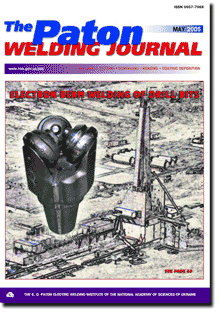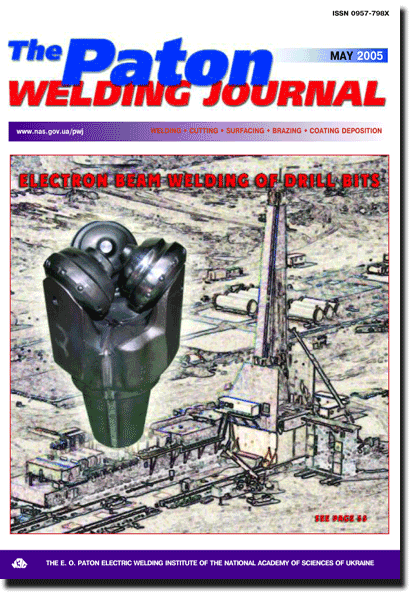

| SCIENTIFIC AND TECHNICAL | |
| Alekseev G.M., Dilthey U., Gumenyuk A.V., Turichin G.A., Lopota V.A., Shilov S.S., Grigoriants A.G., Shiganov I.N., Misyurov A.I., Masychev V.I. and Sysoev V.K. Outlook for application of laser-light technologies | 2 |
| Trends in development of laser welding, including hybrid processes, are considered. It is shown that application of laser-light equipment holds promise in terms of reduced power consumption and widened technological capabilities. The fields of potential efficient application of laser-light technologies are noted. | |
| Yushchenko K.A., Savchenko V.S., Chervyakova L.V. and Zvyagintseva A.V. High-temperature gas corrosion of nickel alloy turbine blades during operation | 8 |
| The character of gas corrosion of power plant blades made from nickel alloy Inconel 738 has been studied. It is shown that redistribution of alloying elements occurs in a narrow zone adjoining the crack surface. Evaluation of microhardness showed the loss of strength taking place in this zone. | |
| Skulsky V.Yu. Metal structure in the fusion zone and HAZ of welded joints on high-chromium heat-resistant steels | 10 |
| It is shown that a coarse-crystalline structure may form in the region between the weld and HAZ in fusion welding of high-chromium martensitic steels of P91 type. This structure is a fusion zone, wherein the base metal grains undergo a different degree of melting,. Segregation and diffusion redistribution of carbon may lead to formation of a relatively decarburized ferritic phase (d-ferrite) within the fusion zone. Moreover, this zone is characterized by formation of coarse grains of primary austenite. It is shown that metal in the HAZ in the tempering region located behind the phase recrystallization region loses its strength. | |
| Maly A.B., Butenko Yu.V. and Khorunov V.F. Weldability of high-alloyed heat-hardenable nickel-base alloys (Review) | 19 |
| Causes of hot cracking of the weld metal in fusion welding of high-alloyed heat-hardenable nickel-base alloys have been analysed. It is shown that recommendations available in literature on elimination of cracks are applicable only for alloys with a low content of the gВ-phase. Ways of solving this problem for alloys with a high content of aluminium and titanium are indicated. | |
| Kuzmin S.V. Kinetics of acceleration of elements of multilayer metal stack plates in explosion welding | 23 |
| Main principles of the kinetics of acceleration of a multilayer stack plates in explosion welding are considered. The effect of initial welding conditions on the character of variations in the collision velocity at the second interlayer boundary has been evaluated by an example of a three-layer stack. | |
| Lazebnov P.P. Corrosion electrochemical properties of CrДNi deposited metal in alkaline media (Review) | 26 |
| Data are given on corrosion resistance of chromium-nickel deposited metal in alkali environments. Short information is given on the influence of alloying elements on the electrochemical corrosion processes running in the metal of chromium-neckel welds. | |
| INDUSTRIAL | |
| Pismenny A.S. and Kislitsyn V.M. Application of hydrogen and its mixtures for environmentally clean metal joining processes | 32 |
| Prospects for improving metal joining methods with a purpose of decreasing evolution of harmful materials polluting the environment are considered. One of the variants of improving the known welding, brazing and soldering methods is the use of hydrogen as a shielding-reducing atmosphere for highly concentrated and pulsed heating methods. Conditions for safe application of hydrogen and its mixtures with oxygen in welding, brazing and soldering processes have been evaluated. | |
| Lebedev V.A. Mechanized cutting of metals with application of PSh107R semi-automatic machine | 36 |
| The paper considers some features of practical use of the process of mechanized arc cutting of metals with application of a special semi-automatic machine of PSh107R type from the series of semi-automatic machines of a modular design. Several techniques and technologies are proposed that allow a significant increase of the speed of cutting and pulsed feed of the electrode wire. | |
| Samotugina Yu.S. Technological peculiarities of local strengthening of high-strength cast iron | 39 |
| A possibility is shown of a considerable increase of abrasive wear resistance of high-strength cast iron in plasma surface treatment with deposition of a strengthened layer of a discrete structure. The extent of increase of the wear resistance depends on the treatment mode, direction of plasmatron displacement and relative area of the strengthened surface. | |
| Kashirsky Yu.V. and Zubchenko A.S. Information bank of structural materials and welding consumables | 42 |
| The bank provides information on 2,000 Russian (ex-USSR) and more than 21,000 foreign grades of materials, which include steels, cast irons, alloys and plastics, used in power engineering, metallurgy, transportation and heavy mechanical engineering. It contains knowledge on different weldability properties of these materials, their manufacture and supply, as well as their analogs. | |
| BRIEF INFORMATION | |
| Kiselevsky F.N. and Kolyada V.A. Calibration of triangular optical sensors | 48 |
| Procedure of calibration of triangular optical sensors used in automation of welding processes has been offered. It allows calibration of sensors after their assembly into welding equipment under the industrial conditions. | |
| Lesnoj A.B., Kasatkin O.G. and Zamkov V.N. Information system for welding of titanium and its alloys | 50 |
| Possibilities of using specialised software for welding titanium and titanium alloys are considered. The offered information system contains data on methods and parameters for welding butt, fillet, T- and overlap joints of different thickness, on welding consumables (electrodes, wires, fluxes), as well as reference data on titanium alloys, allowing selection of titanium alloys depending upon the service conditions of a welded structure. | |
| Zakharov L.S. and Gavrik A.R. Electrodes for manual arc welding of heat-resistant steels with 9 % Cr | 52 |
| Short information is given on development of coated electrodes for welding heat-resistant steels with 9%Cr. The electrodes provide a lower content of diffusion hydrogen in the deposited metal and high physico-mechanical properties of the weld metal. | |
| NEWS | |
| Prof. J. Norrish Е winner of the E.O. Paton Prize of IIW | 54 |
(You are viewing the simplified file contents)
The cost of subscription/purchase order journals or individual articles
| Journal/Currency | Annual Set | 1 issue printed |
1 issue |
one article |
| TPWJ/USD | 384 $ | 32 $ | 26 $ | 13 $ |
| TPWJ/EUR | 348 € | 29 € | 24 € | 12 € |
| TPWJ/UAH | 7200 UAH | 600 UAH | 600 UAH | 280 UAH |
| AS/UAH | 1800 UAH | 300 UAH | 300 UAH | 150 UAH |
| AS/USD | 192 $ | 32 $ | 26 $ | 13 $ |
| AS/EUR | 180 € | 30 € | 25 € | 12 € |
| SEM/UAH | 1200 UAH | 300 UAH | 300 UAH | 150 UAH |
| SEM/USD | 128 $ | 32 $ | 26 $ | 13 $ |
| SEM/EUR | 120 € | 30 € | 25 € | 12 € |
| TDNK/UAH | 1200 UAH | 300 UAH | 300 UAH | 150 UAH |
| TDNK/USD | 128 $ | 32 $ | 26 $ | 13 $ |
| TDNK/EUR | 120 € | 30 € | 25 € | 15 € |
AS = «Automatic Welding» - 6 issues per year;
TPWJ = «PATON WELDING JOURNAL» - 12 issues per year;
SEM = «Electrometallurgy Today» - 4 issues per year;
TDNK = «Technical Diagnostics and Non-Destructive Testing» - 4 issues per year.


